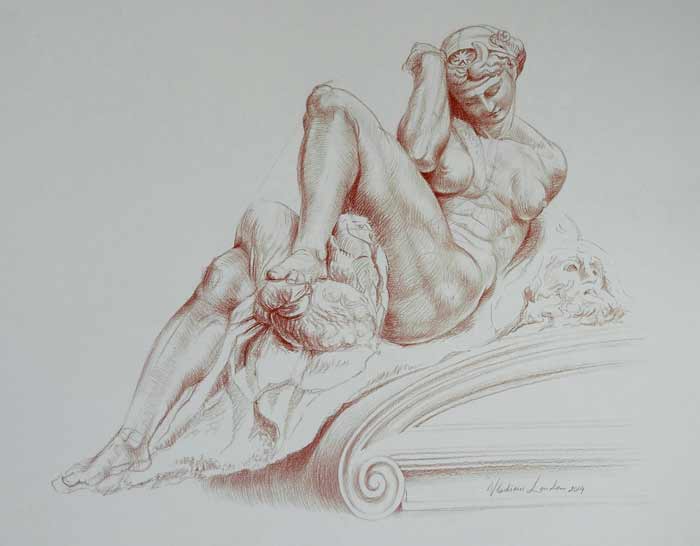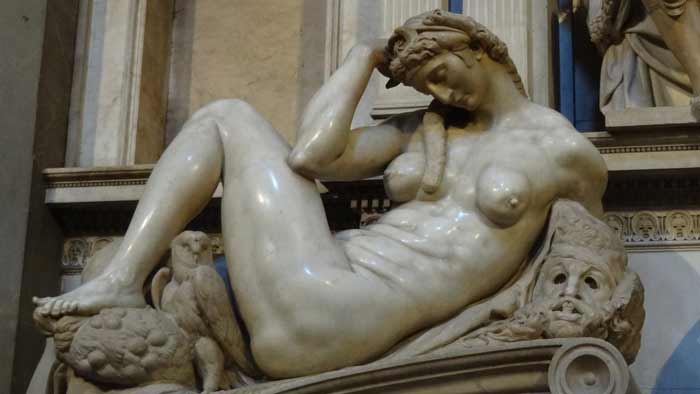The Anatomy Lesson
The Anatomy Lesson
Anatomy Lesson 23
In this anatomy lesson, you will discover not only the essential information on human anatomy for artists, but also get a very helpful guidance on classical drawing techniques.
The Anatomy Lesson for Figurative Artists
The model for this drawing is the female figure of Night carved by the Italian Renaissance sculptor, Michelangelo Buonarroti, between 1526 and 1531.
This figure has a challenging pose, and the anatomy lesson starts from indication of positions and proportions.
The axis of the shoulders is tilted diagonally in perspective. The circle of the first pair of ribs is indicated at the top. The ribcage spans downward, becoming wider.
I am using the virtual lines of constructive drawing to mark the figure’s edges and angles. To learn about constructive principles and how to use them in drawing, you may enroll in the Drawing Academy course, where I explain this topic in detail.


The knee and ankle joints can be indicated with circles. They appear in perspective as ovals, which we see from below. Such ovals are very helpful when defining the proportions of the lower limbs. When dealing with such a complex figure, it is also helpful to draw larger ovals where the upper legs connect to the body.
The kneecap is positioned just above the top edge of the shinbone.
The quadriceps muscle defines the outline of the front of the upper leg.
The calf muscle gives the rear upper half of the lower leg its characteristic outline.
The calf bone is located on the outer side of the shinbone; its top end is discernible near the knee, and the lower end forms the outer anklebone.
The hamstring muscles define the outline of the rear of the thigh.
The mass of the calf muscles fuses into the tendon at roughly the middle of the lower leg, where it becomes slimmer. This tendon then runs into the heel bone.
Let’s examine the figure’s head.
In this position, we see it from above in three-quarters view. It is also tilted to the side.
The two most important constructive lines of the head are the central vertical line of symmetry and the horizontal eye line, which divides the height of the head into two equal halves.
The face is divided into three equal parts:
- The forehead
- The nose
- And the distance from base of the nose to the chin
Because we are looking at the head in perspective, all of these virtual lines are arched.
The figure’s right arm is in the supination position.
The group of muscles called the flexors defines the outline of the forearm. The opposite outline illustrates the extensors group of muscles.
The outer anklebone is located on the same level as the top edge of the foot arch.
With the constructive drawing almost complete, I will now render tonal values in red pencil.
It is advisable to apply pencil strokes along the object’s contours.
Contours should not be confused with outlines. Any three-dimensional object has an infinite number of contours. A contour is a virtual line that can be achieved through the cross-section of an object with a virtual plane. The contour line is where this plane intersects with the surface of the object.
As you can imagine, such a plane can be located at any angle or position, so there is an infinite number of contours for any given object.
Every contour reveals how the surface of the object lies in space. When you apply pencil strokes along these lines, you will portray the three-dimensional nature of the object.
The anatomy lesson delivers more than just anatomy information. Now let me give you some good advice on how to render tonal values.
When planning your artwork, you need to know the darkest shade your drawing tool can provide.
You also need to keep in mind the contrast between the lightest and the darkest values in your piece.
Sometimes, when your drawing tool cannot deliver very dark values or when you don’t plan to make a very deep rendering, you may leave un-rendered not only highlights, but also light areas, in order to maintain contrast.
To do so, start rendering from the darkest areas and gradually build the tonal values up. Eventually you will reach a point when the tones cannot or should not go any darker, and therefore you will stop rendering the light areas as well.
At all times, you need to maintain the relative contrast between light and shadow.
This is like traditional darkroom photography. The darkest values appear first as light tones, then they deepen and mid-tones start to appear; and finally, as the dark and mid-tones become darker, the light areas begin to develop.
By working in this sequence, you will be able to keep control of how tonal values build up throughout the entire drawing process and to make sure the correct contrast between light and dark areas is maintained.
There are several amateurish mistakes to avoid when rendering tonal values:
1. Do not start from one corner of the drawing and move to the other, rendering piece by piece to completion as you go.
2. Do not use all the rendering power that your drawing tool can provide as soon as you begin.
3. Do not render one area of the drawing to the completion while leaving other areas untouched. The entire artwork has to be developed simultaneously and gradually.
4. Do not rub your pencil in both directions on paper. Apply pencil strokes in one direction, lifting the pencil at the end of each stroke.
5. Do not be afraid of visible pencil strokes even in smooth areas of drawing. Pencil marks are your hand signature that makes your artwork and creative style unique.
6. Do not smudge pencil strokes with a finger or paper stump. This is an amateur mistake practiced by self-taught artists.
7. You may place a piece of clean paper under your hand to protect the pencil marks from smudging.
8. Keep your pencil well sharpened at all times. A blunt pencil tip is as bad as a blunt knife. Just ask any chief if you still have doubts.
9. Use a pencil knife to sharpen your pencils; this way you will be able to expose about half-an-inch of the lead. No pencil sharpener will do the same quality job. Pencil sharpeners are only good for children for safety reasons.
10. Use the correct pencil grip. Yes, it is very important and there is such thing as the “correct grip”. To learn more about it, visit the Drawing Academy drawing course…
[ The full lesson is avaibale to Anatomy Master Class members ]
To see the anatomy lesson in full, enroll in the Anatomy Master Class
Simple Pricing, No Surprises
One-time payment - Only $97 USD
ENROLL NOW



